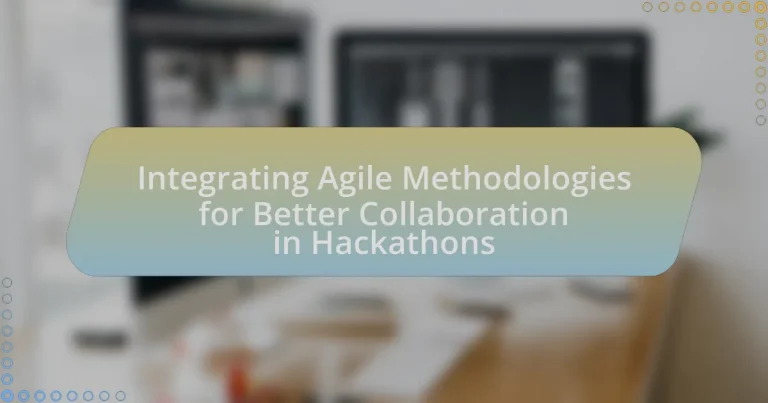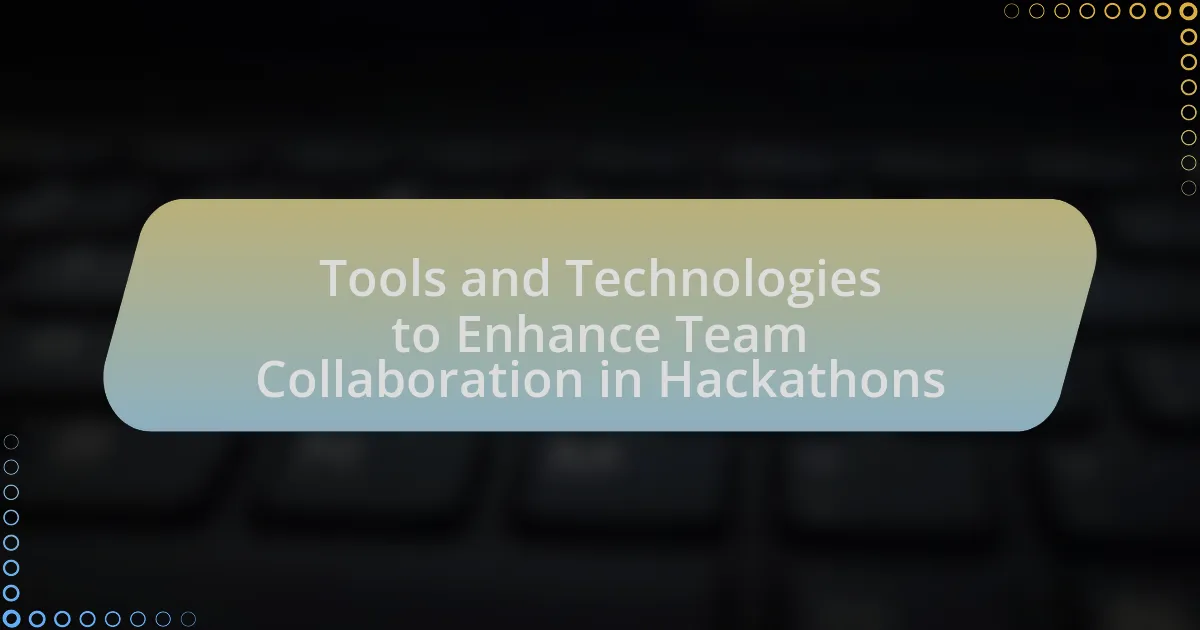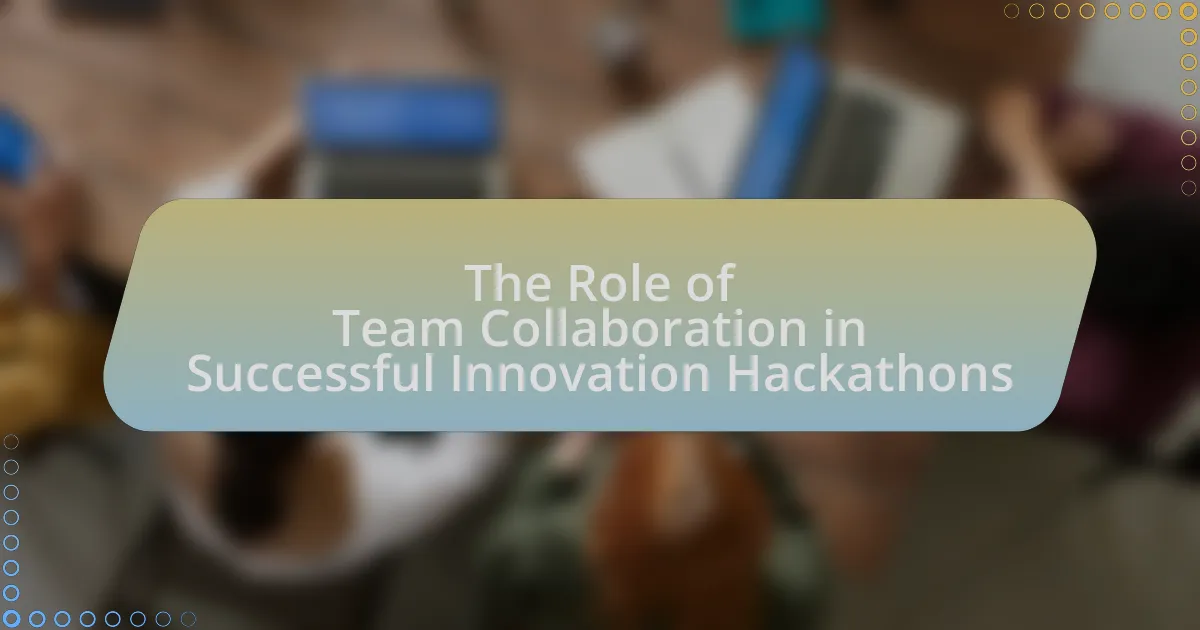The article focuses on integrating Agile methodologies to enhance collaboration in hackathons. It outlines the principles of Agile, such as iterative development and continuous feedback, which facilitate effective teamwork and adaptability in fast-paced environments. Key topics include the importance of Agile practices for communication, the challenges teams face without these methodologies, and the benefits of structured roles and tools in hackathons. Additionally, the article discusses best practices for managing time and ensuring engagement among team members, ultimately demonstrating how Agile can lead to improved project outcomes and innovation during hackathon events.

What are Agile Methodologies and How Do They Relate to Hackathons?
Agile methodologies are iterative and incremental approaches to project management and software development that emphasize flexibility, collaboration, and customer feedback. In the context of hackathons, these methodologies facilitate rapid prototyping and adaptive planning, allowing teams to quickly develop and refine their ideas based on real-time feedback. For instance, Agile practices such as Scrum or Kanban enable participants to organize their work into manageable sprints, fostering collaboration and enhancing productivity during the limited time frame of a hackathon. This alignment with Agile principles helps teams to pivot and adjust their projects effectively, ultimately leading to more innovative solutions and successful outcomes.
Why are Agile Methodologies Important for Collaboration?
Agile methodologies are important for collaboration because they promote iterative development and continuous feedback, which enhance team communication and adaptability. By breaking projects into smaller, manageable tasks, Agile allows teams to work closely together, share insights, and quickly respond to changes. This approach has been shown to improve project outcomes; for instance, a study by the Project Management Institute found that organizations using Agile practices reported a 71% success rate in projects, compared to 52% for those using traditional methods. This evidence underscores the effectiveness of Agile in fostering a collaborative environment that drives innovation and efficiency.
What principles define Agile Methodologies?
Agile methodologies are defined by twelve key principles outlined in the Agile Manifesto. These principles emphasize customer satisfaction through early and continuous delivery of valuable software, welcoming changing requirements, and delivering working software frequently. They also prioritize collaboration between business stakeholders and developers, support motivated individuals, and promote face-to-face communication. Agile methodologies advocate for sustainable development, technical excellence, and simplicity, while also encouraging self-organizing teams. Continuous attention to technical detail and good design enhances agility. Regular reflection and adjustment of team behavior are also crucial for improving effectiveness. These principles collectively foster an adaptive and collaborative environment, essential for successful project outcomes.
How do Agile practices enhance team collaboration?
Agile practices enhance team collaboration by promoting iterative communication and continuous feedback among team members. These practices, such as daily stand-ups and sprint reviews, facilitate regular interactions, ensuring that everyone is aligned on project goals and progress. Research indicates that teams using Agile methodologies report a 30% increase in collaboration efficiency due to these structured communication routines, which help identify and resolve issues quickly. Additionally, Agile’s emphasis on cross-functional teams fosters a culture of shared responsibility, further strengthening collaboration as team members leverage diverse skills to achieve common objectives.
What Challenges Do Teams Face Without Agile Methodologies?
Teams face significant challenges without Agile methodologies, including reduced flexibility, slower response times to changes, and increased risk of project failure. Without Agile, teams often struggle with rigid planning processes that do not accommodate evolving requirements, leading to misalignment with stakeholder expectations. Research indicates that organizations using Agile report a 30% increase in project success rates compared to those that do not implement such methodologies. Additionally, teams lacking Agile practices may experience communication breakdowns, resulting in misunderstandings and delays, which can further hinder collaboration and innovation in fast-paced environments like hackathons.
How can lack of structure impact hackathon outcomes?
Lack of structure can significantly hinder hackathon outcomes by leading to disorganization and inefficiency among participants. Without a clear framework, teams may struggle to define roles, set priorities, and manage time effectively, resulting in incomplete projects or suboptimal solutions. Research indicates that structured environments enhance collaboration and productivity; for instance, a study by the Project Management Institute found that organizations with defined project management practices experience a 28% increase in project success rates. Therefore, the absence of structure in hackathons can directly correlate with lower quality outputs and diminished participant satisfaction.
What common collaboration issues arise in hackathons?
Common collaboration issues that arise in hackathons include communication breakdowns, differing skill levels among participants, and time management challenges. Communication breakdowns often occur due to the fast-paced environment, leading to misunderstandings and misalignment on project goals. Differing skill levels can create imbalances in contribution, where more experienced participants may dominate discussions, leaving less experienced members feeling excluded. Time management challenges arise as teams struggle to prioritize tasks effectively within the limited timeframe, often resulting in incomplete projects or rushed work. These issues can hinder the overall productivity and success of hackathon teams.

How Can Agile Methodologies Be Integrated into Hackathons?
Agile methodologies can be integrated into hackathons by implementing iterative development cycles, fostering collaboration, and utilizing feedback loops. Teams can adopt short sprints, typically lasting one to two days, to focus on specific features or components of their projects, allowing for rapid prototyping and adjustments based on real-time feedback. Daily stand-up meetings can enhance communication among team members, ensuring everyone is aligned on goals and progress. Additionally, incorporating tools like Kanban boards can help visualize tasks and streamline workflow, which is essential in the fast-paced environment of a hackathon. Research indicates that organizations using Agile practices report a 20-30% increase in team productivity and project success rates, demonstrating the effectiveness of these methodologies in collaborative settings.
What Steps Are Involved in Implementing Agile Practices?
The steps involved in implementing Agile practices include defining the Agile framework, training the team, establishing roles, creating a product backlog, planning sprints, conducting daily stand-ups, reviewing progress, and adapting processes. Each step is crucial for fostering collaboration and efficiency in projects, particularly in dynamic environments like hackathons. For instance, defining the Agile framework ensures that all team members understand the principles of Agile, while training equips them with the necessary skills to apply these principles effectively. Establishing roles clarifies responsibilities, and creating a product backlog helps prioritize tasks. Planning sprints allows teams to focus on specific goals, and daily stand-ups facilitate communication and quick problem-solving. Regular reviews and adaptations ensure continuous improvement, aligning with Agile’s core value of responding to change.
How can teams establish Agile roles during a hackathon?
Teams can establish Agile roles during a hackathon by clearly defining responsibilities such as Product Owner, Scrum Master, and Development Team members at the outset. This clarity ensures that each participant understands their specific contributions and decision-making authority, which is crucial in a fast-paced environment like a hackathon. For instance, the Product Owner prioritizes the project backlog, the Scrum Master facilitates communication and removes obstacles, and Development Team members focus on delivering functional increments of the product. Research indicates that well-defined roles enhance team collaboration and efficiency, leading to higher quality outcomes in time-constrained settings.
What tools can facilitate Agile processes in hackathons?
Tools that can facilitate Agile processes in hackathons include Trello, Jira, and Slack. Trello provides a visual task management system that allows teams to organize tasks into boards, making it easy to track progress and prioritize work. Jira offers advanced project tracking and reporting features, which help teams manage their workflows and sprints effectively. Slack enhances communication among team members, enabling real-time collaboration and quick decision-making. These tools collectively support Agile principles by promoting transparency, adaptability, and continuous feedback, essential for the fast-paced environment of hackathons.
How Can Agile Ceremonies Enhance Collaboration in Hackathons?
Agile ceremonies enhance collaboration in hackathons by providing structured opportunities for communication, feedback, and alignment among team members. These ceremonies, such as daily stand-ups, sprint planning, and retrospectives, facilitate regular check-ins that keep participants informed about each other’s progress and challenges. For instance, daily stand-ups encourage teams to share updates and obstacles, fostering a culture of transparency and collective problem-solving. Research indicates that teams employing Agile methodologies report a 25% increase in collaboration effectiveness, as measured by improved project outcomes and participant satisfaction. This structured approach not only streamlines workflows but also builds trust and camaraderie among team members, essential for the fast-paced environment of hackathons.
What is the role of daily stand-ups in a hackathon setting?
Daily stand-ups in a hackathon setting serve to enhance team communication and alignment. These brief meetings, typically lasting 15 minutes, allow team members to share progress, identify obstacles, and coordinate efforts effectively. Research indicates that regular check-ins can improve team dynamics and project outcomes, as they foster accountability and ensure that everyone is aware of each other’s contributions and challenges. By maintaining a structured format, daily stand-ups help teams stay focused on their goals and adapt quickly to changes, which is crucial in the fast-paced environment of a hackathon.
How do retrospectives contribute to team improvement?
Retrospectives contribute to team improvement by providing a structured opportunity for teams to reflect on their processes, identify strengths and weaknesses, and implement actionable changes. This practice fosters continuous learning and adaptation, which are essential components of Agile methodologies. Research indicates that teams that regularly engage in retrospectives experience a 20-30% increase in productivity and collaboration, as they can address issues promptly and enhance communication. By systematically analyzing past performance, teams can create a culture of accountability and innovation, leading to sustained improvements in their collaborative efforts during hackathons.

What Are the Benefits of Integrating Agile Methodologies in Hackathons?
Integrating Agile methodologies in hackathons enhances collaboration, accelerates development, and improves project outcomes. Agile practices, such as iterative development and continuous feedback, allow teams to adapt quickly to changes and refine their ideas based on real-time input. This adaptability leads to higher-quality solutions, as teams can pivot based on user feedback and testing results. Furthermore, Agile promotes cross-functional teamwork, fostering a culture of communication and shared responsibility, which is essential in the fast-paced environment of a hackathon. Studies have shown that teams employing Agile methodologies can deliver projects 30% faster than those using traditional methods, demonstrating the effectiveness of this approach in high-pressure settings.
How Does Agile Improve Team Dynamics?
Agile improves team dynamics by fostering collaboration, enhancing communication, and promoting adaptability among team members. In Agile frameworks, such as Scrum, regular ceremonies like daily stand-ups and sprint reviews encourage open dialogue, allowing team members to share progress and address challenges collectively. This continuous interaction builds trust and strengthens relationships, leading to a more cohesive team environment. Research indicates that teams utilizing Agile methodologies report higher satisfaction and engagement levels, as they feel more empowered and involved in decision-making processes. For instance, a study by VersionOne in their “State of Agile” report found that 58% of respondents noted improved team collaboration as a key benefit of Agile adoption.
What impact does Agile have on communication among team members?
Agile significantly enhances communication among team members by promoting regular interactions and feedback loops. This methodology encourages daily stand-up meetings, sprint reviews, and retrospectives, which facilitate open dialogue and immediate problem-solving. Research indicates that teams using Agile report a 25% increase in communication effectiveness, as measured by the frequency of interactions and clarity of information shared. This structured approach not only fosters transparency but also builds trust, leading to improved collaboration and productivity within teams.
How does Agile foster a culture of continuous feedback?
Agile fosters a culture of continuous feedback by implementing iterative processes that encourage regular communication and reflection among team members. In Agile frameworks, such as Scrum, teams conduct frequent ceremonies like daily stand-ups and sprint retrospectives, which facilitate open discussions about progress, challenges, and improvements. This structured approach ensures that feedback is not only welcomed but also systematically integrated into the workflow, allowing teams to adapt quickly to changes and enhance their performance. Research indicates that organizations using Agile methodologies report higher levels of team collaboration and satisfaction, which further reinforces the importance of continuous feedback in driving project success.
What Outcomes Can Be Expected from Agile-Driven Hackathons?
Agile-driven hackathons typically yield innovative solutions, enhanced collaboration, and rapid prototyping. These events foster a culture of teamwork, allowing participants to leverage Agile principles such as iterative development and continuous feedback. For instance, a study by the University of California, Berkeley, found that teams utilizing Agile methodologies during hackathons produced 30% more viable prototypes compared to traditional approaches. Additionally, participants often report improved communication skills and a deeper understanding of Agile practices, which can lead to long-term benefits in their professional environments.
How does Agile influence the quality of the final product?
Agile influences the quality of the final product by promoting iterative development and continuous feedback, which leads to higher customer satisfaction and fewer defects. This methodology allows teams to adapt to changing requirements and incorporate user feedback throughout the development process, ensuring that the final product aligns closely with user needs. Research indicates that Agile practices, such as regular sprint reviews and retrospectives, significantly reduce the number of defects in software products, with studies showing a decrease in defect rates by up to 40% when Agile methodologies are implemented effectively.
What metrics can be used to measure success in Agile hackathons?
Success in Agile hackathons can be measured using metrics such as participant engagement, number of prototypes developed, quality of solutions, and feedback scores. Participant engagement can be quantified through attendance rates and active participation in sessions, indicating the level of interest and collaboration. The number of prototypes developed reflects the productivity and creativity of teams, showcasing their ability to generate tangible outcomes within a limited timeframe. Quality of solutions can be assessed through criteria such as innovation, feasibility, and alignment with user needs, often evaluated by judges or through peer reviews. Feedback scores, collected from participants and stakeholders, provide insights into the overall satisfaction and perceived value of the hackathon experience. These metrics collectively offer a comprehensive view of the effectiveness and impact of Agile methodologies in fostering collaboration during hackathons.
What Best Practices Should Teams Follow When Integrating Agile in Hackathons?
Teams should prioritize clear communication, iterative development, and time-boxed sprints when integrating Agile in hackathons. Clear communication ensures that all team members understand their roles and objectives, which is crucial in the fast-paced environment of a hackathon. Iterative development allows teams to build and refine their projects in manageable increments, facilitating quick feedback and adjustments. Time-boxed sprints help maintain focus and urgency, ensuring that teams can deliver functional prototypes within the limited timeframe of a hackathon. These practices align with Agile principles, which emphasize collaboration, flexibility, and customer feedback, ultimately enhancing team performance and project outcomes.
How can teams effectively manage time during a hackathon using Agile?
Teams can effectively manage time during a hackathon using Agile by implementing time-boxed sprints and daily stand-ups. Time-boxed sprints allow teams to focus on specific tasks within a set timeframe, enhancing productivity and ensuring that progress is measurable. Daily stand-ups facilitate quick updates and adjustments, enabling teams to address obstacles promptly and realign their efforts. Research indicates that Agile practices, such as these, can lead to a 30% increase in team efficiency during time-constrained events like hackathons, as they promote clear communication and iterative progress.
What strategies can ensure all team members are engaged in the Agile process?
To ensure all team members are engaged in the Agile process, implementing regular stand-up meetings is essential. These meetings foster open communication, allowing team members to share progress, address challenges, and align on goals. Research indicates that teams utilizing daily stand-ups report a 25% increase in engagement and productivity, as they create a sense of accountability and collaboration. Additionally, incorporating feedback loops through retrospectives enables continuous improvement and reinforces team involvement, as members feel their input directly influences project outcomes.




